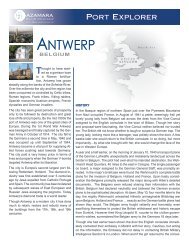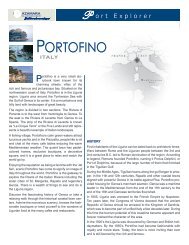Download Port Explorer Guide - Azamara Club Cruises
Download Port Explorer Guide - Azamara Club Cruises
Download Port Explorer Guide - Azamara Club Cruises
You also want an ePaper? Increase the reach of your titles
YUMPU automatically turns print PDFs into web optimized ePapers that Google loves.
In the 17th – 19th centuries, the Canaries experienced economic<br />
ups and downs due to their dependence on various<br />
crops. Sugar became the first staple crop but profits declined<br />
with the arrival of cheaper sugar form the West Indies. Grapes<br />
became the main crop producing a sweet white wine called<br />
Malmsey which retains worldwide recognition. In the mid-19th<br />
century the Canaries were given free port status which lowered<br />
duties and trade barriers. Las Palmas and Tenerife became<br />
two of the world’s busiest ports. With the introduction of<br />
the banana crop as a major export and the increasing growth<br />
of tourism, the Canaries continue to have a stable economic<br />
base.<br />
LA PALMA PLACES OF INTEREST<br />
Santa Cruz is a city of brightly colored homes, ornate balconies,<br />
charming plazas and steep alleyways. There is a Museum<br />
of Natural History, Naval Museum and numerous art<br />
galleries to explore. Real Street is the center of commerce<br />
and Espana Square is where the 16th century Town Hall and<br />
church Iglesia del Salvador can be found.<br />
Santuario Virgen de Las Nieves is located a few kilometers<br />
out of town in the hills overlooking the city. The image of the<br />
island’s patroness resides in a beautiful 16th century renaissance<br />
building.<br />
Roque de los Muchachos is the islands highest mountain at<br />
2, 426 meters above sea level. Located atop the mountain are<br />
several important astrophysics observatories.<br />
Mirador de la Cumbrecita is one of the well-known overlooks<br />
on the island. From here there are panoramic views and<br />
great photo opportunities of the island.<br />
Caldera de Taburiente, This National<br />
Park was created in 1954. The park has<br />
one of the largest craters in the world<br />
with a circumference of 28,000 meters.<br />
The national treasure also has hundreds<br />
of streams, falls, and unique species of<br />
trees considered authentic living fossils.<br />
San Pedro is famous for its cigar makers and the “Palmero”<br />
cigar. Cigar production became part of the craftsmanship of<br />
La Palma by the end of the 19th century when emigrants returned<br />
to the island from Cuba. Great care and skill are used<br />
in cultivation, curing and production to make some of the finest<br />
cigars in the world.<br />
Fuencaliente was a much sought after spa before the 17th<br />
century. The soothing properties of the hot water springs gave<br />
the town its original name, Fuente Santa, or Holy Fountain.<br />
When the San Antonio Volcano became active for a period of<br />
two months in 1677, the lava flow buried the Holy Fountains.<br />
The volcanic soil of the area is now famous for the wines its<br />
produces.<br />
Breña Alta can be found nestled on the hills of the east coast.<br />
The village has panoramic views of the sea and mountains<br />
and is known for its sunrises making it a natural location for<br />
vacation villas.<br />
La Galga is a tiny town situated right on the edge of two deep<br />
gorges. The viewpoint Mirador de San Bartolo provides photo<br />
opportunities of the spectacular terrain.<br />
Los Tilos has been declared a Biosphere reservation by<br />
UNESCO. The lush park contains Canarian Holly trees,<br />
Strawberry trees and the Canarian bellflower.<br />
Los Sauces is the prosperous and principal farming and<br />
commercial center of the northern part of the island. The fertile<br />
area has one of the densest forests on the island.<br />
Charco Azul are natural seawater swimming pools formed by<br />
lava flowing into the ocean. The pools are a popular destination<br />
and famous for their clarity.<br />
San Antonio Volcano is estimated to be around 3,200 years<br />
old. The Visitors Centre offers insights into the powerful forces<br />
at work within a volcano and views of the San Antonio crater.<br />
Teneguia Volcano is the youngest of the Canary Island volcanoes.<br />
Teneguia last erupted in October 1971. The eruption<br />
produced enough lava to increase the dimensions of the island.
















